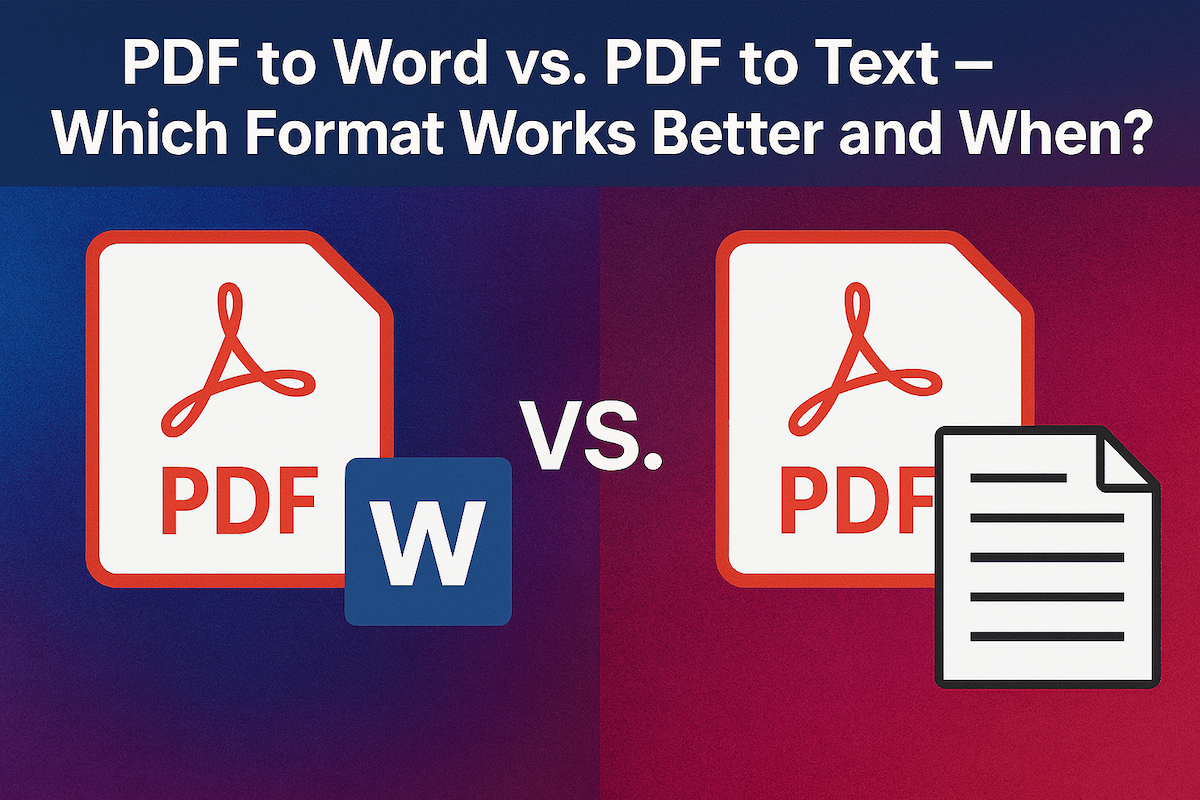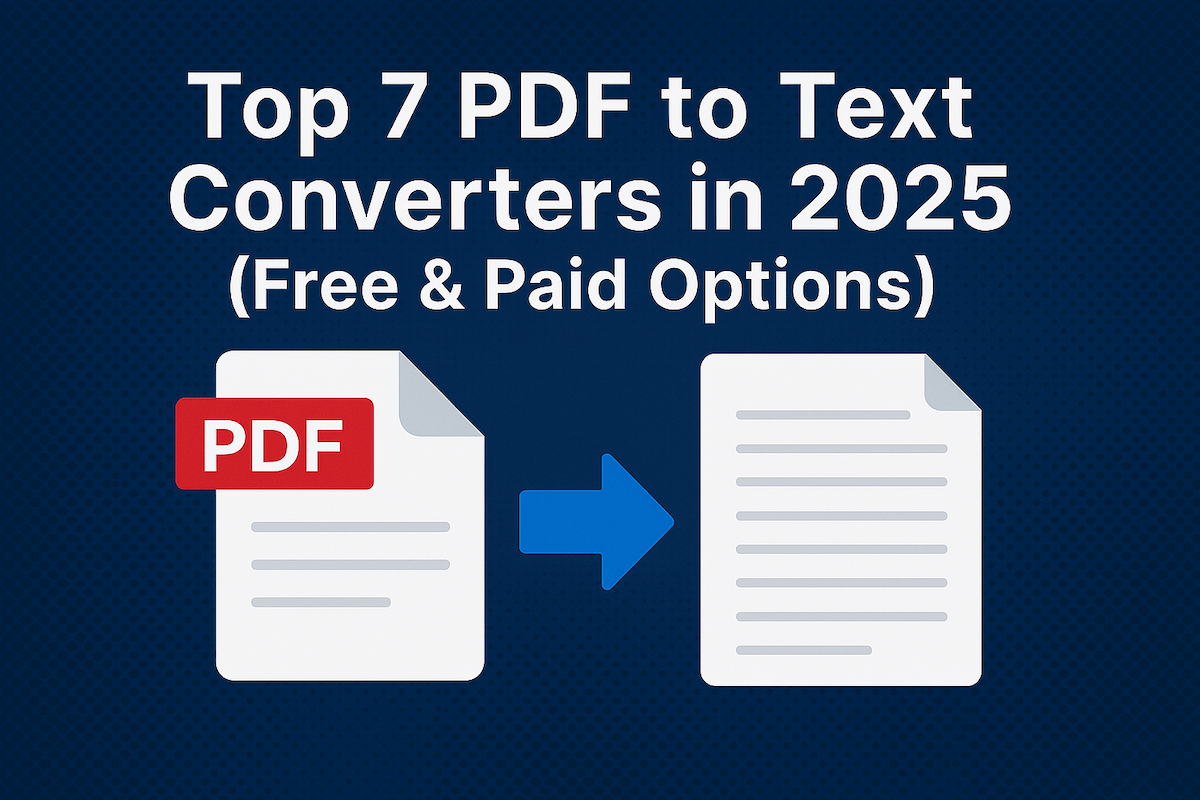PDF to Word vs. PDF to Text - Which Format Works Better and When?
Last updated

Understanding the distinctions between document formats like PDF, Word (DOCX), and plain text (TXT) is crucial when deciding how to handle your digital documents. Each format serves a different purpose and has unique characteristics. PDFs are designed to preserve layout and formatting, making them ideal for sharing and printing where consistency across devices is key. Word documents, conversely, are built for creation and extensive editing, offering robust formatting capabilities but requiring specific software. Plain text files, on the other hand, are the simplest form, containing only unformatted characters and providing maximum compatibility and ease of processing. Knowing these differences helps illuminate why converting between them requires careful consideration of your final objective.
Understanding Document Formats: PDF, Word, and Text
PDF: The Fixed-Layout Standard
PDF, or Portable Document Format, is the go-to standard for creating and sharing documents when maintaining visual consistency is paramount. It's designed to ensure that the document looks the same regardless of the software, hardware, or operating system used to view it. This makes PDFs perfect for final reports, digital publications, and archiving, as they lock down formatting, fonts, images, and layouts precisely as intended. While they can contain interactive elements, their primary strength lies in their static presentation.
Word (DOCX): The Editable Document
Microsoft Word documents (typically saved with a .docx extension) are the industry standard for word processing. Unlike PDFs, Word files are inherently editable and designed for dynamic content creation. They offer a wide array of formatting options, styles, and tools for manipulating text, inserting objects, and structuring documents. Editing Word files requires compatible software, such as Microsoft Word itself or alternative office suites. This format is best suited for documents that are still under development or require frequent revisions.
Plain Text (TXT): Pure Content
Plain text files (.txt) represent the most fundamental way to store text data. They contain only the raw characters-letters, numbers, and symbols-without any formatting information like fonts, sizes, colors, bolding, or italics. Images, tables, and other non-textual elements are not included. This simplicity makes TXT files universally compatible across virtually all software and operating systems. They are incredibly lightweight and are often used for simple notes, coding, data logs, or anytime you need the content itself stripped of any presentation layer.
PDF to Word vs. PDF to Text: Choosing the Right Conversion
When faced with a PDF and the need to work with its content, the choice often comes down to converting it to Word or plain text. The decision hinges entirely on your ultimate goal and how you intend to use the information. Understanding what each conversion achieves and its limitations is key to picking the right approach.
Converting PDF to Word: When Editing is Your Goal
The primary purpose of converting a PDF to Word is to transform the static PDF content into an editable document. This conversion attempts to retain as much of the original layout, formatting, and elements as possible, allowing you to make changes using familiar word processing tools. The benefit here is gaining the ability to easily edit, restructure, or reformat the text, tables, and potentially images within the document. However, this process isn't always perfect. Due to the fundamental differences in how PDFs and Word documents handle structure and layout, complex PDFs often result in conversion errors, requiring significant manual cleanup and reformatting in the resulting Word file.
Converting PDF to Text: When You Just Need the Words
If your objective is simply to extract the raw textual content from a PDF, ignoring all formatting and visual elements, then converting PDF to Text is the most direct and efficient method. This process strips away everything but the characters, producing a simple, unformatted .txt file. The main benefit is receiving clean, pure text that is universally compatible, easy to search, copy, paste, and analyze. It's ideal for data extraction, scripting, or when formatting would be cumbersome or irrelevant. What you should expect is a loss of all visual formatting-fonts, colors, layout, images, tables-as the output is purely a stream of text.
Deciding Between Word and Text Conversion
- Choose PDF to Word if: You need to make extensive edits to the document's content, structure, or formatting. Be prepared for potential post-conversion cleanup, especially with complex layouts.
- Choose Convert PDF to Text if: You only need the raw, unformatted text content for searching, copying, pasting, or analysis, and formatting is unnecessary or even detrimental to your task.
- If exact layout is critical: Neither conversion is suitable. In such cases, using a dedicated PDF editor to modify the PDF directly is the best approach.
Easily Convert PDF to Text with 500PDF Convert PDF to Text
Need to quickly get the text out of a PDF? Our free online tool is designed for simplicity and speed, making it easy to convert PDF to Text whenever you need raw content.
Benefits of using 500PDF to convert PDF to Text:
- Quick and easy to use interface.
- No software installation is required; access it directly in your browser.
- Secure and private handling of your documents.
- Works seamlessly on any device and browser.
- Free to use without requiring account registration.
- Special features available when using a 123doc account to log in:
- Enjoy unlimited usage of the conversion tool.
- Documents from your 123doc account are automatically synced, ready to convert without re-uploading.
Deciding between converting PDF to Word and converting PDF to Text depends entirely on your objective. If detailed editing is necessary, Word conversion is the path, though formatting issues are common. If simple, portable, unformatted text is all you need, converting to plain text is the most efficient solution. Understand your goal first to choose the right tool for the job.
